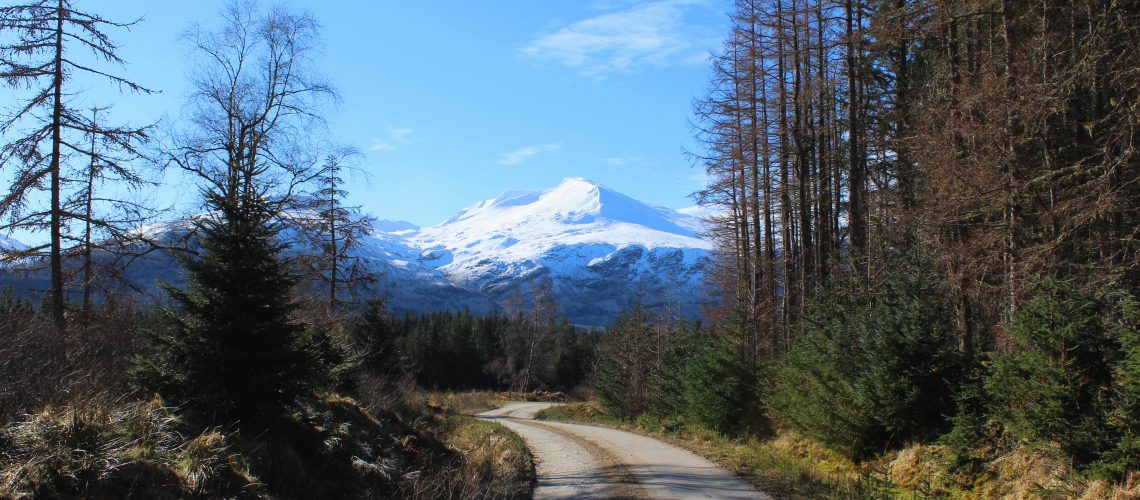
Having spent a couple of months in the Highlands last autumn while we trapped pine martens for translocation to Wales, subsequently followed by a couple of months in the office (recuperating?!), it was great to head back to the Highlands in early March. We were greeted with some glorious spring-like weather, stunning snow-topped mountains and, mercifully, no midges!
The task at hand was to survey forests where we plan to capture pine martens this autumn, under licence from Scottish Natural Heritage, for our second translocation to Wales. To do this, we surveyed for and collected pine marten scats. This gives us an index of pine marten activity. Subsequent genetic analysis can tell us the minimum number of pine martens in each forest, by identifying the individual genotype (fingerprint) of the scats. We carried out the survey work in March as this is the time of year when the pine marten population is at its annual low prior to breeding taking place during late March and April. Previous work has shown that the densities of pine marten scats on forest tracks can have seasonable variations of 100-fold, with the fewest marten scats found during the winter. Therefore, surveying at this time of year means we will make conservative estimates of the activity and number of pine martens at these sites.
We found good numbers of scats in all of the forests we surveyed and selected sites where we will trap pine martens later in the year. Most marten scats were filled with small mammal (mostly vole) fur and bones, and also bird quills and berries. Strangely, one was full of chewing gum! That was a first for us!
As always, we were treated to sightings of plenty of other species, or at least their field signs. Red and roe deer were widespread, frogs and toads were in abundance and we recorded signs of wild boar in the area. Two of our surveyors were even lucky enough to see a pine marten crossing a forest track while they were out surveying! (No, I’m not envious at all!…).
Pine martens often visit gardens for a free meal in the Highlands. Interestingly, the owner of the house we stayed in reported that pine martens had taken up residence in his house a couple of years ago and he saw them not infrequently in the garden where they had taken advantage of exploring his wheelie bins! We optimistically put a camera trap up in the garden, baited with some leftovers from dinner, and were very pleased to record a pine marten on the camera.
Pine marten recorded on camera trap in the garden (courtesy of Huw Denman)
We also re-surveyed the sites from which we took pine martens last autumn for translocation to Wales. We wanted to survey these sites to assess what impact, if any, removing the small numbers of pine martens last autumn might have had on the population. It was really interesting to return to these sites and reminisce about our trapping experience, remembering which pine martens came from where. We found good numbers of scats at each of the sites and it was reassuring to see that martens remain widely distributed in these forests. Future genetic analysis will be able to provide detailed information on the numbers of pine martens in each of these forests before and after the removal of animals for translocation. After a successful couple of weeks, we headed back south with a cool-box overflowing with scats.
Back in Wales, this is a really crucial time for the pine martens: the breeding season is kicking off and we are hoping that some of our females will breed and produce the first kits that Wales has seen for some time. Pine martens mate in July/August and have delayed implantation so don’t become pregnant until the following spring. It’s very likely that some of our female martens had been mated before we translocated them, and will be giving birth any day now. The team in Wales have been intensively radio-tracking the females, identifying their den sites and putting up den boxes which make safe and snug natal den sites. We plan to set up camera traps at or near these den sites ready to catch footage of the moment when the marten kits leave the den and take their first steps outside with their mother. This probably won’t be until May, as marten kits don’t become very mobile until they are about six weeks old.
So, exciting times for the project in both Wales and Scotland. Keep an eye out for the next blog when we will hopefully be able to give an update on whether we have heard the pitter patter of furry (marten) feet in Wales….
Lizzie Croose, Mustelid Conservation Officer